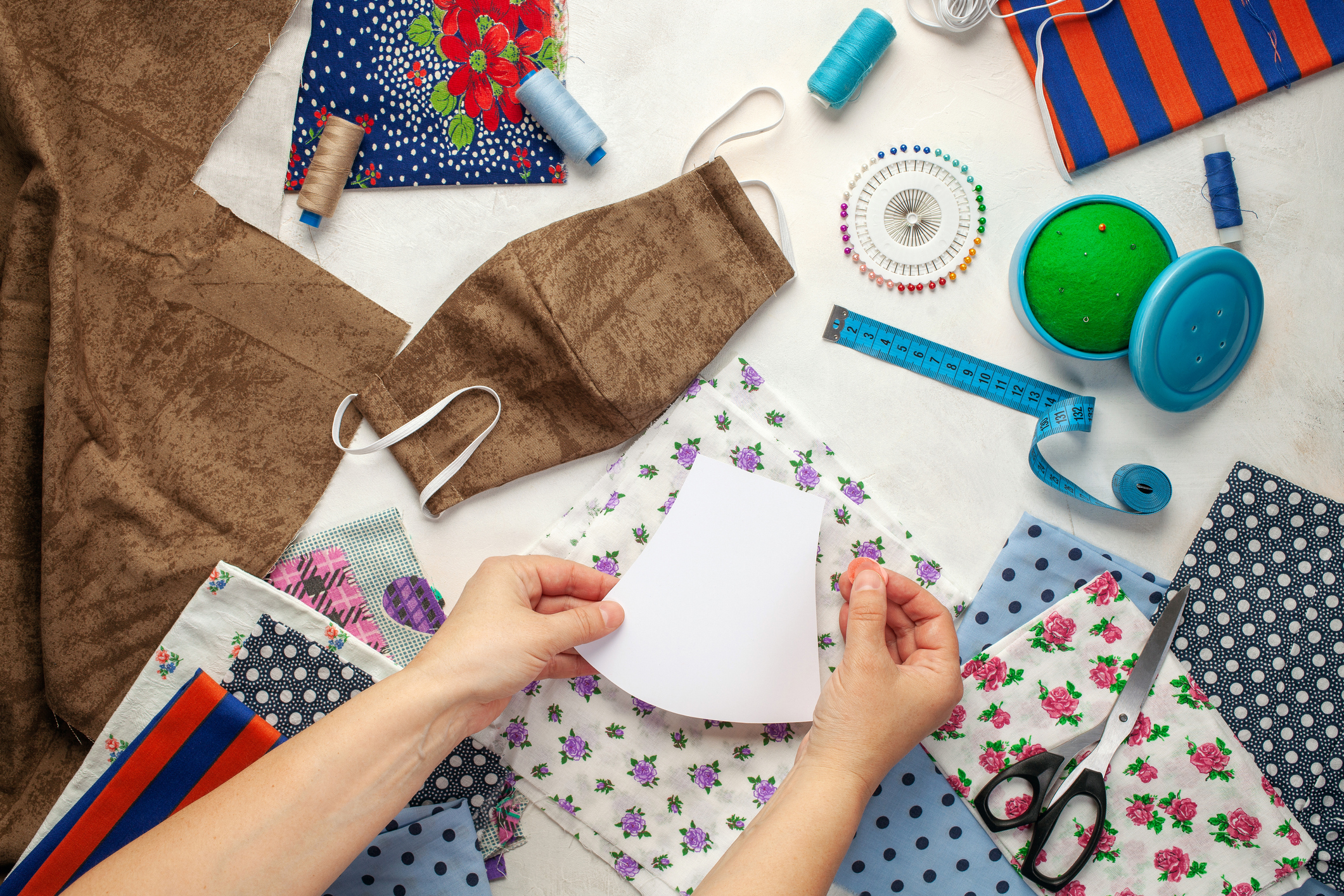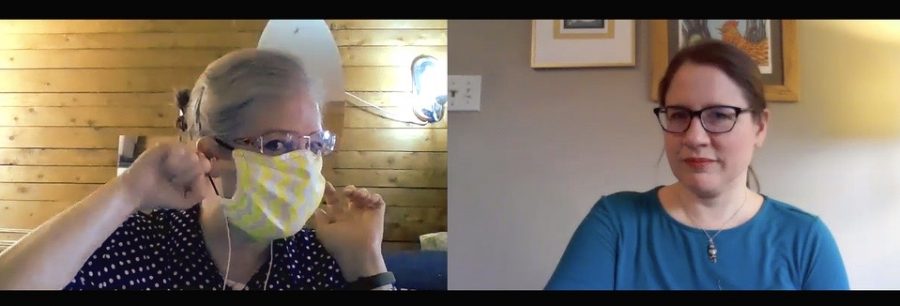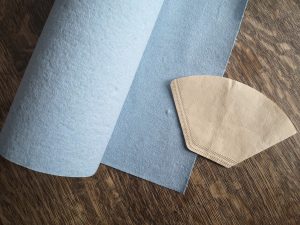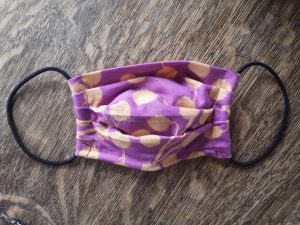 Written by Alison, staff member, Central Library; and Sharon, staff member, Musquodoboit Harbour Public Library
Written by Alison, staff member, Central Library; and Sharon, staff member, Musquodoboit Harbour Public Library
Homemade face masks became a popular Do-It-Yourself (DIY) project for many of us after the provincial and federal, opens a new window governments suggested they could play a part in reducing the spread of COVID-19. Health authorities have been very clear that wearing a homemade facial covering in the community has not been proven to protect the person wearing it and is not a substitute for physical distancing and hand washing. However, wearing a mask helps to minimize the spread of your own respiratory droplets to other people and to surfaces around you.
It can be difficult to know what masks work well, which patterns are simple to make, and which ones fit snugly, so we decided to make and critique six different make-at-home masks, and share the results with you in a video review., opens a new window
Making your own mask
A great homemade face mask should be made of at least two layers of tightly woven material, and should fit snugly on your face, covering your mouth and nose with no gaps. Of course, it’s important that it’s comfortable too! If your mask doesn’t fit well, you will be tempted to readjust it while you’re wearing it, and we all know that we’re not supposed to be touching our faces, ESPECIALLY when we’re out in public. A recent study, opens a new window shows that using a layer of nylon stockings over a homemade mask makes it fit more snugly, and greatly increases the effectiveness of all homemade mask designs.

Materials for your mask
What can you use to make your mask? Most sites, opens a new window recommend using high quality quilting cotton, but many of us are stuck with what we already have at home. Luckily, there are some great mask fabric options that most of us have around the house, including
- Pillow cases
- Old sheets
- Cotton t-shirts
- Blue shop towels
Some people also choose to include a filter with their mask, and these can be made with materials found at home, too:
- Interfacing
- Coffee filters
- Paper towels
- Blue shop towels
- Dry Swiffer-style sheets

However, it is important to remember that including filters doesn’t necessarily increase the effectiveness of a mask, and can even reduce the usefulness if it is difficult to breath through, as air is more likely to escape through the sides.
But which pattern is best?
With these recommendations in mind, we started looking for a few easy patterns to share with you, and quickly became overwhelmed by the number of video tutorials and articles out there. A lot of highly rated patterns, opens a new window looked complicated to sew, and required a printed pattern template to cut out the fabric. We tried to find patterns that included a filter pocket and a nose wire to ensure a snug fit, and were also simple to cut and sew.
We settled on six basic patterns to test. Alison made the patterns as they were written, and Sharon used her fashion design studies experience to tweak and modify the patterns to make them work even better.
We settled on the following criteria to determine our favourite (and least favourite) masks:
- How simple or complicated is the mask to make?
- Is the mask comfortable to wear for long periods of time?
- Does the mask pass “the smell test” when Sharon wears it while cleaning out her kitty litter box?
Here are the designs we made, in order of easiest to most complex:
Government of Canada’s Non-Medical Masks and Face Coverings
There are three patterns on this link, opens a new window - two no-sew patterns and one very simple pattern. The no-sew patterns are extremely simple: one is made from cutting off the bottom of a cotton t-shirt, and the other is a folded bandana with a coffee filter in the middle.
Of the two no-sew designs, we feel the folded bandana mask would probably work the best, because it’s six layers of folded fabric along with a coffee filter. If you don’t have a sewing machine, this is the design that we’d recommend you use. The directions don’t include it, but a wire of some kind can easily be inserted into the top fold in order to make this mask fit snugly across the bridge of the nose.
The simple sewn pattern requires elastic for the ear loop, although plain rubber bands could be substituted. The sewn mask had large gaps on the sides of the mouth and under the chin. It might work better than nothing, but it was our least favourite of all of the sewn masks.
A Flat Mask with Filter Pocket and Nose Wire
Both Sharon and Alison really liked this mask., opens a new window It is very simple to make, includes a filter pocket and nose wire, and, best of all; it uses a cord tie to fasten around your face instead of elastics. The cord makes this mask adjustable and comfortable to wear over an extended period. We found that it was easy to substitute out different components for this mask - instead of the recommended foam garden ties for the nose wire, we tried pipe cleaners, tripled up twist ties, and a section from a wire coat hanger. We also liked that it was easy to find substitutions for the cord - a long shoelace, parachute cord, or plain butcher’s twine would work equally well.

Alison noticed that when she added a double layer of blue shop towel to her flat mask style, more air escaped out of the sides of the mask, reducing its effectiveness. However, this style passed Sharon’s kitty litter test when used with a pre-washed Swiffer-style dry sweeping cloth. It’s not the cutest style out of our tests, but it worked pretty well, as long as the sides are drawn up snug around your face.
Pleated Mask with Ear Loops
This mask, opens a new window was slightly more complicated to make, but easy enough for a beginner, as long as you used a slightly different technique to fold the pleats than recommended in the original video. Sharon and Alison agreed that this pattern would probably be pretty tricky to make if you don’t have an electric iron to press down the pleats.
Sharon got quite creative with this style, and made several variations, including one style that had a dry sweeping cloth sewn right into the layers, one style that used a long cord like the flat mask pattern, and even one made out of two coffee filters sandwiched between two paper towels. All of her samples passed the kitty litter test, as long as she used a filter.
 This mask is cute and comfortable, with a great, snug fit provided by the pleated fabric. We also liked that there was a filter pocket and nose wire. The only thing that makes this mask a little less comfortable is the fact that it uses ear loops, which can make your ears sore after extended wearing.
This mask is cute and comfortable, with a great, snug fit provided by the pleated fabric. We also liked that there was a filter pocket and nose wire. The only thing that makes this mask a little less comfortable is the fact that it uses ear loops, which can make your ears sore after extended wearing.
Duck Bill Style Mask
Of all the patterns we tested, this mask, opens a new window, from the University of Florida, was the most complicated to make. Some studies show it as a very effective style, especially when used with the Halyard H600 medical fabric. We didn’t have any of this special material on hand, so Sharon used the same cotton fabric she used on the rest of her tests.
This style did NOT pass the kitty litter test. We suspected that this might be because of the seams that go directly over the nose and mouth. It may be that the Halyard H600 fabric is the key to the success of this pattern. As it was also the trickiest to sew, we don’t recommend this style if you’re using standard fabric.
Video review
To watch more of our testing procedures and to listen to us discuss the different masks in greater detail, check out our video review.
Reading list:
Homemade face masks cannot be tested scientifically because there are too many variables in the types of fabric, and the physiology of individuals' faces may mean that a mask that works great for one person may leave large gaps on another. Please review the literature below for some scientific studies of homemade masks.
Simple Respiratory Mask, opens a new window by Virginia M. Dato, David Hostler, and Michael E. Hahn
Testing the Efficacy of Homemade Masks: Would They Protect in an Influenza Pandemic? Disaster Medicine and Public Health Preparedness, opens a new window by Anna Dacies, Katy-Anne Thompson, Karthika Giri, George Kafatos, Jimmy Walker, and Allan Bennett
Assessment of Fabric Masks as Alternatives to Standard Surgical Masks in Terms of Particle Filtration Efficiency, opens a new window by Amy Mueller and Loretta Fernandez
Simple Respiratory Protection—Evaluation of the Filtration Performance of Cloth Masks and Common Fabric Materials Against 20–1000 nm Size Particles, opens a new window by Samy Rengasamy, Benjamin Eimer, and Ronald E. Shaffer
Evaluating the efficacy of cloth facemasks in reducing particulate matter exposure, opens a new window by Kabindra M. Shakya, Alyssa Noyes, Rana Kallin, and Richard E. Peltier



Add a comment to: DIY Fabric Masks: We Review 6 Styles